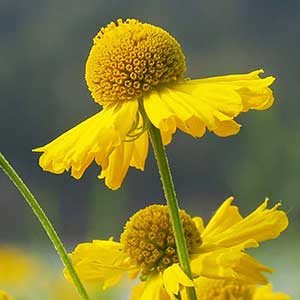Helenium autumnale
common sneezeweed
often with 4+ branches, glabrous or puberulent.
basal usually withered by flowering;
cauline lanceolate-elliptic or oblanceolate, 3–13 cm, bases attenuate or truncate, decurrent;
margins generally entire but with some denticulate or serrate-dentate;
tips acute;
surfaces glabrous or minutely glandular.
8–23 mm in diameter.
8–21;
corollas 10–23 mm, yellow.
200–400+;
corollas 2.5–5 mm, yellow, sometimes brownish distally.
5–12 mm, linear;
surfaces puberulent.
1–2 mm, brown, sparsely hairy, pappi of 5–7 aristate scales, 0.5–1.5 mm.
5–70+, radiate;
peduncles moderately to densely hairy.
=32, 34, 36.
Helenium autumnale
Riverbanks, lake shores, wet meadows, swamps, marshes. Flowering Jul–Oct. 0–1500 m. Casc, Col, CR, ECas, Sisk, WV. CA, ID, NV, WA; throughout most of North America. Native.
This species was formerly divided into variety grandiflorum and variety montanum, but the morphological differences between varieties are too minor and intergrading to merit taxonomic recognition.
Kenton Chambers
- Local floras:
BC,
CA,
OR,
WA
- Local Web sites:
CalFlora,
CalPhotos,
Flora NW,
PNW Herbaria,
Turner Photog.
WildflowerSearch
iNaturalist (observations)
USDA Plants Database
- LBJ Wildflower Center
- SEINet
- Plants of the World Online
- Encyclopedia of Life
- Wikipedia
- Google Image Search



